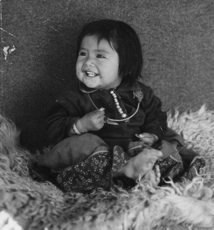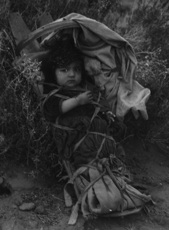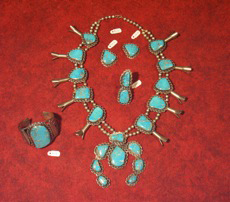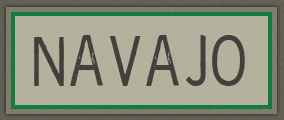Demography
 Spanning Arizona, New Mexico, and Utah, the Navajo Nation covers seventeen million acres and constitutes one-third of all Indian lands in the lower forty-eight states. The Navajo Reservation is larger than ten of the fifty states in America and larger than Connecticut, Massachusetts, Rhode Island, Maryland, and Delaware combined. The traditional Navajo land is encompassed within the four sacred mountains that were created by the Holy People for the Navajos. In the east isSis Naajinii , or Mt. Blanca; in the south, Tsoodził, or Mt. Taylor, near Grants, New Mexico; in the west, Dook´o´oosłííd, or Mt. Humphreys, near Flagstaff, Arizona; and in the north, Dibé Ntsaa, or Mt. Hesperus. Today the Navajos form the largest Native American nation with about 270,000 members, a majority of whom live within the Navajo Nation borders.
Spanning Arizona, New Mexico, and Utah, the Navajo Nation covers seventeen million acres and constitutes one-third of all Indian lands in the lower forty-eight states. The Navajo Reservation is larger than ten of the fifty states in America and larger than Connecticut, Massachusetts, Rhode Island, Maryland, and Delaware combined. The traditional Navajo land is encompassed within the four sacred mountains that were created by the Holy People for the Navajos. In the east isSis Naajinii , or Mt. Blanca; in the south, Tsoodził, or Mt. Taylor, near Grants, New Mexico; in the west, Dook´o´oosłííd, or Mt. Humphreys, near Flagstaff, Arizona; and in the north, Dibé Ntsaa, or Mt. Hesperus. Today the Navajos form the largest Native American nation with about 270,000 members, a majority of whom live within the Navajo Nation borders.
Brief History
 The Navajo tell the story of the Emergence, in which First Man brought the four sacred mountains that mark the Navajo homeland into the Earth-Surface World. Anthropologists hypothesize that the Navajo split off from the Southern Athabaskans and migrated into the Southwest between 200 and 1300 A.D.
Between 900 and 1525 A.D. the Navajos developed a rich and complex culture in the area of present-day northwestern New Mexico. The Navajos may have moved into southeastern Utah as early as 1620; by the eighteenth century they had spread into northeastern Arizona and southeastern Utah.
The Navajo tell the story of the Emergence, in which First Man brought the four sacred mountains that mark the Navajo homeland into the Earth-Surface World. Anthropologists hypothesize that the Navajo split off from the Southern Athabaskans and migrated into the Southwest between 200 and 1300 A.D.
Between 900 and 1525 A.D. the Navajos developed a rich and complex culture in the area of present-day northwestern New Mexico. The Navajos may have moved into southeastern Utah as early as 1620; by the eighteenth century they had spread into northeastern Arizona and southeastern Utah.
The Navajos came into contact with early Spanish explorers in the sixteenth century. By the late-eighteenth century, the Navajos had become involved in direct conflict with Spanish forces intent on conquering the Southwest. Many fell victim to the Spanish slave trade. Slave raids and massacres escalated after Mexico gained its independence from Spain in 1821, and the Navajos were forced to move out of their traditional homeland and into areas like southern Utah.
The situation worsened after the United States took New Mexico from the Republic of Mexico in August 1846. For the next fifteen years, the Navajo were forced to move around constantly to protect their families and livestock from the American army. The culmination of hostilities came in 1863, when the U.S. Army, under the command of James Carleton and led by former Indian fighter and Ute agent Christopher “Kit” Carson, used “scorched earth” tactics to force the surrender of the Navajo. This defeat resulted in the infamous Long Walk from their homeland to Fort Sumner in central New Mexico. Hundreds died or disappeared during the grueling three-hundred-mile forced march. Those who survived were held at the overcrowded, undersupplied, insanitary Bosque Redondo Reservation at Fort Sumner.
After four years of interment in horrific conditions, an 1868 treaty allowed the Navajo to return to their original homeland. The Navajo Reservation has subsequently been enlarged through executive order and special legislation, including an 1884 executive order through which much of the land in present-day southeastern Utah was added. The Navajo raised goats and sheep and eventually developed a barter economy, exchanging rugs and silverwork with white traders. In the 1920s, oil and mineral exploration began in the Four Corners region. Oil, gas, and minerals have brought wealth to the Navajo Nation and Utah, but development has also caused a range of environmental problems.
Language and Culture
 Linguistically, the Navajo are related to the Apaches and to the Athabascans (the Dene) of northern Canada. The Navajo language is an essential element of the life, culture, and identity of the Navajo people. The Navajo Nation recognizes the importance of preserving and perpetuating that language for the survival of the Navajo Nation.
Their traditional arts consist of finely woven blankets, detailed silver and turquoise jewelry, and a distinct style of painting based on “sandpaintings,” which were originally used in healing ceremonies. Navajos are unsurpassed in their ability to create exquisite and multi-faceted art. Navajo silversmithing, basket-weaving, and rug-weaving are renowned throughout the world.
Linguistically, the Navajo are related to the Apaches and to the Athabascans (the Dene) of northern Canada. The Navajo language is an essential element of the life, culture, and identity of the Navajo people. The Navajo Nation recognizes the importance of preserving and perpetuating that language for the survival of the Navajo Nation.
Their traditional arts consist of finely woven blankets, detailed silver and turquoise jewelry, and a distinct style of painting based on “sandpaintings,” which were originally used in healing ceremonies. Navajos are unsurpassed in their ability to create exquisite and multi-faceted art. Navajo silversmithing, basket-weaving, and rug-weaving are renowned throughout the world.
The Navajo believe there are two classes of beings: the Earth People and the Holy People. The Holy People are believed to have the power to aid or harm the Earth People. Since Earth People of the Navajo are an integral part of the universe, they must do everything they can to maintain harmony or balance on Mother Earth. The number four plays an important role in traditional Navajo philosophy. In the Navajo culture there are four directions, four seasons, the first four clans, and four colors that are associated with the four sacred mountains. The four directions also are represented by four colors: White Shell represents the East; Turquoise, the South; Yellow Abalone, the West; and Jet Black, the North. In most Navajo rituals there are four songs or multiples thereof.
When there is disorder in a Navajo’s life, such as an illness, medicinemen use herbs, prayers, songs, and ceremonies to help cure patients. There are more than fifty different kinds of ceremonies that may be used in the Navajo culture—all performed at various times and for specific reasons.





